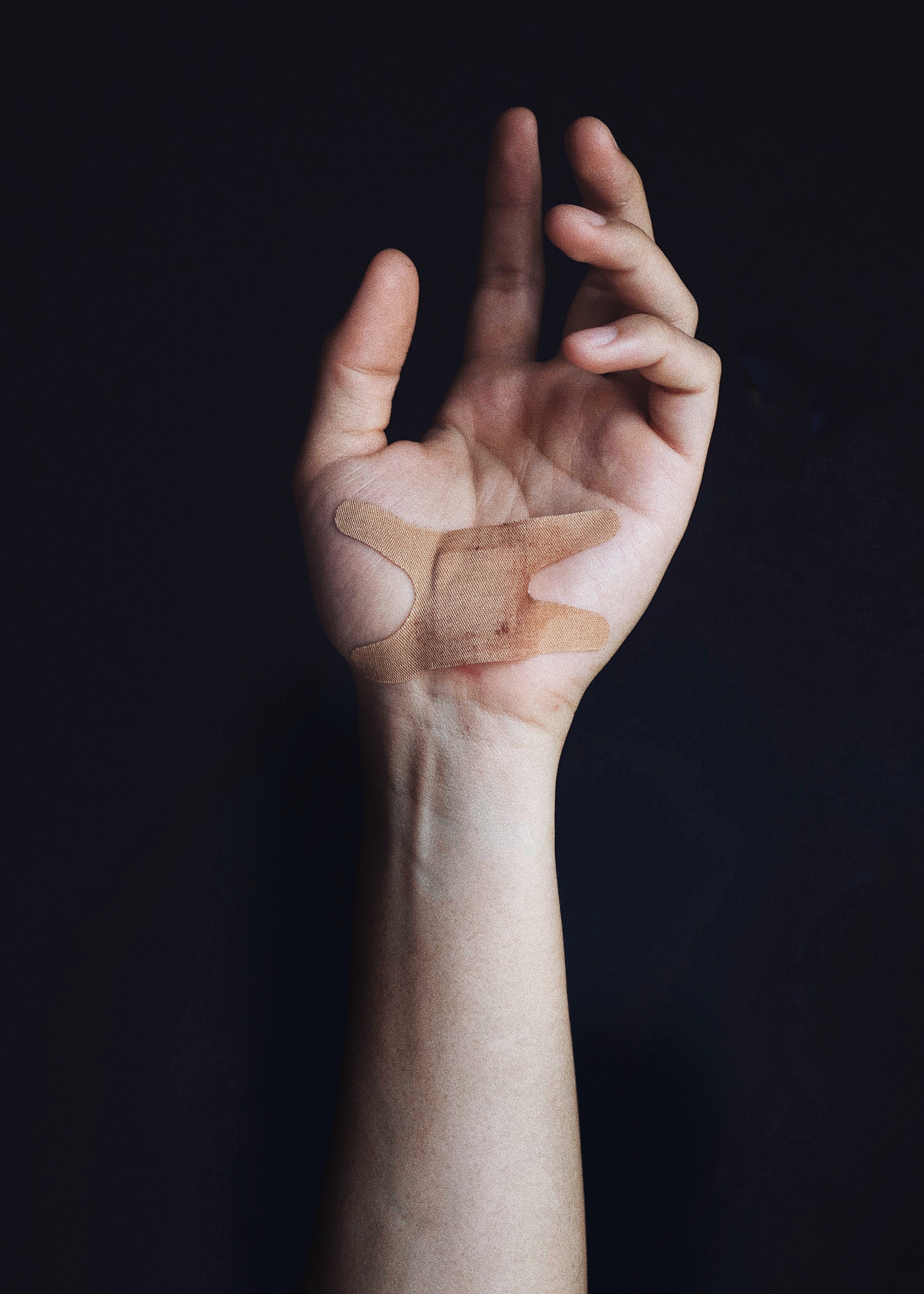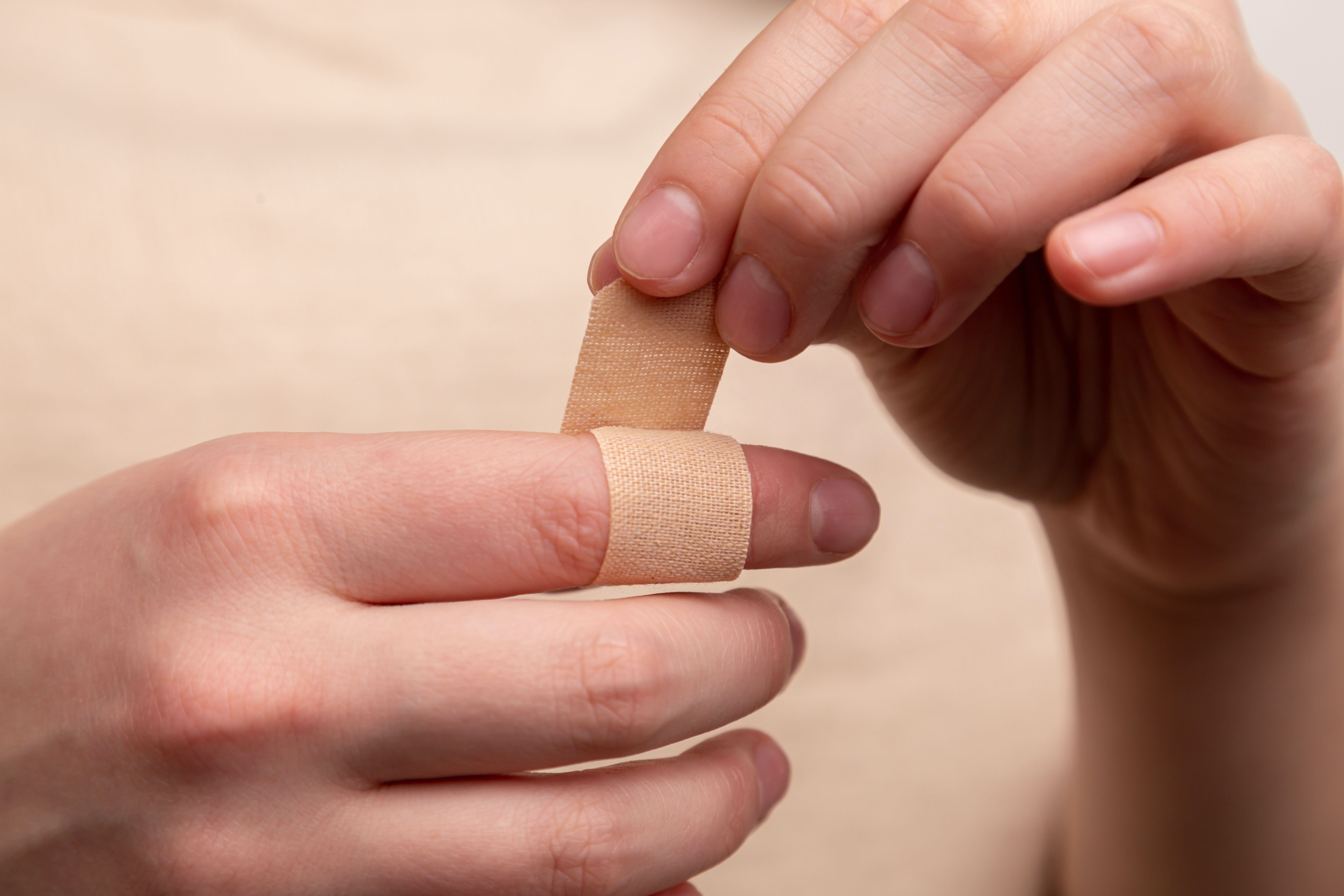Wounds-Part 1
Taner tried to hold her fingers steady as she sterilized the gash on the soldier’s leg with the cleansing spell, sliding her gloves through the blood and removing all dirt and bacteria. The sword hadn’t cut through the femoral vein, but only by a hair’s width. Taner kept her eyes focused on the skin bordering the gash like book ends. It had to be perfectly cleaned. If not, she would sign her patient’s death warrant, sealing bacteria under the soldier’s skin and in their blood. It hadn’t happened yet, and like hell was she going to let that happen.
Her patient had stopped moaning. Daring a glance up from her work, Taner could see the patient’s eyes rolled back and their lips turning the slightest blue hue. Their body was becoming colder and colder by the second. But they were still breathing. “Don’t you dare,” Taner said, her fingers twisting into the next incantation. “Don’t you dare go out on me.” She began convincing the wound to close, but the skin refused to move faster than a glacier. How much more blood could this one lose?
Holding her hands above the soldier’s chest, she coaxed the bone marrow to begin to create more red blood cells as she summoned water into their veins. Not pure water; Taner balanced summoning the correct ratio of salt and fresh water to create saline. She counted ten seconds, and then checked her patient.
The soldier’s lips still refused to fill with color, their skin cool and clammy under Taner’s gloves. “No,” Taner cursed under her breath. “No. No! I closed the wound! I summoned the right amount of blood. You should be waking up!” They always did. Every time she filled their organs with precious blood. Had she misspoke the spell? Taner quickly swiped her hand along the soldier’s body. Her glove, stainless from the cleansing spell, came back with no new blood. “You’re not bleeding,” Taner said, her breathing increased. “You’re not bleeding. I sewed you up. You’re not leaking. Why are you still in shock?”
Taner hurriedly checked the soldier again. The bruises and cuts she had seen earlier hadn’t changed. She hadn’t healed them, but they weren’t life threatening now. “Where are you hiding?” she asked as if searching for a rodent escaped in her tent.
The words of her mentor whispered in her ear. What if the leak is not on the outside?
“SURGEON!” She yelled. “SURGEON! I have internal bleeding, and I need to get to that wound, NOW!”
You Wounded Me!
If you have ever read a high fantasy or thrilling Sci-Fi book, chances are your favorite character has gotten hit. Thwacked. Stabbed. Concussed. Beat-up.
Depending on said character, the list could be a few miles long. And depending on the genre, said injuries can range from “barely described” to “gut-churningly descriptive” (I’m looking at you, horror genre). Thankfully, the stories I tend to gravitate towards are on the “tamer” side of bloodied descriptions.
(…Which is hilarious, considering that I studied pictures of trauma wounds back during EMT training with no reaction. Different tolerances in different contexts, I suppose).
However, these stories also have the habit of getting injuries flat out wrong.
But I watch someone get knocked out by a swift blow to the head for the umpteenth time and can’t help myself thinking, “Uh, I think that character’s dead.” That’s a solid concussion, and your brain can only take so many of those over a period. And one does not wake up from that just a tiny bit drowsy.
Originally, I wanted this to be a comprehensive list of injuries and how they work, but that would make for a ridiculously long blog. So, we’re breaking it into chunks! This first one is based on blood loss, general injuries like cuts, stabs, and bruises. I will discuss how to generally treat these injuries in the field/at the scene, but not in the hospital. That’s a whole other post.
Disclaimers and Content Warnings

Before we continue, I just need to put a few content warnings here: CW for discussing wounds!
I did once have an EMT and wilderness first responder license, but those have since expired (because, you know… grad school and weird state laws. I never got to use my EMT training when I moved briefly to Washington State, and then I went the research route.) So most of this is from what I remember from training, and the few times I had to use my training on bike rides.
And remember: this is a fun blog, and not a replacement for calling emergency medical services when someone is hurt IRL! Don’t be the person who steps forward and says, “Fear not, I read about this once on the internet, I can help!” That will not be the inspiring speech you think it is.
Now that the disclaimer section is done, let’s dive into discussing a small plethora of wounds!
How Much Blood is Too Much? The Answer May Shock You

This website has actual calculations for how much blood someone can lose before things “go south” for them, but a relative far more knowledgeable than I in the way of medicine says that an easy estimate for how much blood the body can lose is 40%. Past that point, the body goes into shock.
What is shock? When we break down its medical name, “hypoperfusion,” we see hypo = less, and perfusion= passage of blood. This means that shock occurs when your body can’t get blood to the necessary tissues. The body starts to do everything it can to preserve the key organs like the heart or brain.
There are three phases of shock:
1) Compensated: The patient is still able to function, but we can see that the body is starting to feel it’s oats. What’s happening here is that for whatever reason, your body is struggling to pump blood to your organs (more on that down below). So, it goes into “survival mode” and starts moving all of the blood to the vital organs and brain. The person becomes confused and anxious (called “altered mental status) as their brain is struggling to get blood. They may even get nauseous. Their skin will start to become clammy/wet and cold to the touch, and their lips may start to change to a blue.
2) Decompensated: This is the “start moving your butt for treatment” phase. The body starts having issues shunting blood to the brain and vital organs. Generally happens when one has lost ~30% of their blood. The body becomes cold; you can’t feel a pulse anywhere but at the largest arteries; their heartrate has skyrocketed to compensate for the blood loss; blood pressure drops; the skin becomes ashen or blue; the person has most likely become unconscious, and their pupils may become huge as their eye muscles start to relax.
3) Irreversible: As the name suggests, this is the “point of no return.” The individual is no longer alive as they can’t push enough blood to the vital organs no matter how much medical help is given.
There are a couple of ways shock can happen. We have cardiogenic shock (heart has issues pumping like a heart attack), septic shock (bacteria infiltrate the blood stream and the body to has a drop in blood pressure), anaphylactic shock (blood pressure drops from an allergic reaction), and finally, hypovolemic shock (as the name suggests, “low blood volume”).
Hypovolemic shock is the one we’re going to worry about in this post, as it’s when the blood can’t get around the body because too much of it has leaked out of the blood vessels. Note that I say “blood vessels” and not just “body,” because you can internally bleed yourself to shock.
Why do I take the time to discuss this? Well, in fiction, death is usually written as a beautiful thing. A mentor is stabbed through the gut, and they have enough wits about them to say a heartfelt goodbye and reveal unspoken secrets about the main character’s backstory. Reality check: I saw someone about to go into decompensated shock (they were having a heart attack) and they were not writing soliloquies of the beauty of life. They thought they were going to die, they were struggling to stay awake, and they were terrified.
I don’t say this to terrify you, readers. I say this because I think in fiction, we don’t take advantage of this for death scenes (I know. It’s quite a sentence to write. But I am also a writer and a Dungeon Master, and I do have a sadistic love of twisting the knife during emotional scenes). I’m just saying: which is more emotionally charged? A parental figure having a heartfelt moment as they announce the main character’s royal lineage, or that same figure mentally deteriorating from a mortal wound? Imagine them going in and out of conciousness in their last moments and can’t recognize anyone or remember where they are as the main character fights to heal them.
Fun fact: For a long while, people were taught to raise the legs to push blood to the upper body. Then, for my EMS class, they told us to never do that. Now, the technique is apparently back in use. There’s new literature out that says that in certain situations, leg raising can help big time with shock. Talking to my physician family members, they say (and I quote): “There’s no downside to do it. We don’t do [leg raising] in the trauma room… We do abdominal compression.”
Other physician family member: “[Abdominal compression] fell out of favor even more than raising legs…Not standard of care.” (Cue a discussion on updating treatments that I did not write down).
For more in-depth info on shock, check out this EMS website!
Wound Care (AKA Keeping It Clean)

A dire wolf sinks its teeth into a character’s leg. A warrior sees blood forming on their clothes from a knife cut. A noble sprints through the woods from assassins and falls down a cliff, the sharp branches raking at their bleeding limbs.
And they just walk it off???
This is where books will start to lose me as a reader. You were just bit by a wolf, with teeth that have touched who-knows-what and have been who-knows-where. Where’s the wound care? Clean that stuff out!
Story time: I was approached in college to look at a scrape on someone’s knee about a week after I had completed my wilderness first responder class. Keep in mind, this person had hurt themselves on campus, in civilization, and yet when I saw their scrape, it was covered in a yellow scab and leaking yellow puss. Luckily, they had access to antibiotics that took care of it within a few days, but not everyone has easy access to antibiotics, especially in a fictional world.
If you have an open wound, even a scrape, and you are in the wilderness, your character needs to take the time to scrub every last fleck of dirt from that wound. If there are rocks imbedded in the scrape, pick them out. From personal experience, it is painful. One needs to wash it with clean water (using boiled water should work in a survival situation) and clean rags. One can also place an antibiotic on the wound; your setting will determine what antibiotic is available.
Can’t clean that wound properly? Welp, be prepared for an infection! Things like staphylococcus, E.coli, or even flesh-eating bacteria can take up residence in that open cut. First comes the itching, the burning, the headaches, which can all build to sepsis. Sepsis is when your body is so overwhelmed by the bacteria in your bloodstream that it starts doing everything to destroy the infection, even if it means killing the host.
Therefore, if your character has taken a nasty open wound, they need to take the time to clean and dress the wound. Again, really badass when they just walk it off, but that could lead to said character’s descent into septic shock and death.
But what does this mean in terms of a fantasy magic system? If you have some magical healer on your fictional team, this means that they have the cleaning and sterilization abilities of a god. Perhaps their spells clean and heal at the same time, or maybe they have a specific cleaning spell they must focus on first before they can heal. They will wear clean gloves as they work to avoid infection. They keep their tools immaculate and sterile. Their cleansing spells can also keep their clothes clean and sterile. Yes, it can look cool when you show a healer running around from patient to patient with blood all over them like a civil war doctor. However, if the civilization has healing magic, they’ve probably figured out that keeping a healer’s hands clean keeps people alive longer.
“Hey, keeping our healers clean not only protects the healers from blood-borne diseases from patients, but also keeps our patients from dropping from infection? Clean away!”
I’m just saying: this has magic implications!
I Got Poked… Real Bad
Maybe the character is in a fight and gets stabbed! Or, they are hiking through the wilderness and their foot gets skewered by a stick (true story that happened to a friend of mine). Rule #1 that you need to follow: DO NOT RIP OUT THE OBJECT DOING THE IMPAILING (unless it is keeping the person from breathing properly).
Why?
Well, believe it or not, that “thing” that is sticking out of them is now plugging up the deadly hole! Sure, it may look awesome if someone rips an arrow out of their chest and keeps charging, but that character is probably going to die from blood loss. The character needs to keep the stabby-stab object in as they haul their butts to a surgeon or healer.
What should the character do in the meantime? Stabilize the stabby thing. In wilderness first responder training, we improvised with shirts to place around the object’s base to keep it from being moved. For EMT training, we used gauze, and a lot of it. In a survival situation, anything goes if it works (though try to keep it clean). You are aiming to keep the object from 1) coming out and letting lose a stream of the precious red juice and 2) from it moving around more in the body and cutting through any more blood vessels.
“The Blood’s Supposed to Stay Inside, Right?”: Closed soft Tissue Wounds
Ok. Your character is hit with something, but no skin is broken. No scrapes, just getting smacked real hard. What can happen?
Well, generally people start forming a bruise at the area of impact. Sometimes, that bruise starts to form immediately, or it may show up a little while later. The fancy word for a bruise is a “contusion” when small, and a “hematoma” when large; Either way, it’s something that seems, at a glance, a very boring subject to discuss in a post on wounds.
Except it can be an incredibly important detail for other injuries.
See, a bruise forms when blood vessels under the skin burst and allow blood to pool. The area swells. If the person was hit hard enough, though, the huge, dark bruise can be a sign of more serious internal bleeding (I have been told by my physician buddies, this depends on where and how the person was hurt. Not all life-threatening internal bleeding is going to show up externally as a bruise). Organ tissues can tear, broken bones can sever an artery, you name it. Other signs of general internal bleeding include blood in the stool/poop (which sounds funny until that means blood is leaking into the intestines) and signs of shock start to appear (see above).
How to deal with internal bleeding? If it’s life threatening, go to the hospital! No way to deal with that in the field, so that’s when patient transport becomes high priority!
Bruising along one’s spine or neck is a sign of a spinal injury and should be taken incredibly seriously when found after getting smacked or hit by something. It’s not a surefire sign that the spine is incredibly damaged, but it is a sign that the spine took a hit, and it definitely needs to be watched.
And if a character has a bleeding disorder, like their platelets can’t form clots, bruises can be deadly (am I sneaking in my research into this post? Yes. I have no shame). The individual who is a hemophiliac can just keep bleeding and bleeding and bleeding and… you get the idea.
This could be a fantastic explanation as to why a character is a pacificist: if they get into a fight, they may die just from a few bruises. You could have a hot-headed character who would traditionally fall into the “badass fighter main character,” but must figure out a way to manage their temper because they can’t risk getting injured. Or, maybe the hemophiliac character takes medication (like factor replacement therapy) to deal with their bleeding defect, and as they step into a fight, they realize they forgot to take their meds that morning thanks to nerves. Oh crap.
Takeaways?
Does this post barely cover these wound topics?
Oh yes. Absolutely. We’re just getting started! I haven’t even begun to talk about head trauma, chest wounds, broken bones… The possibilities for characters to get hurt and treated is wild! Also, we can start giving healers/responder characters more spotlight, because even with the help of magic, their job can be crucial. And while I based my character suggestions on EMS folk (because I’m pulling from personal experience), you don’t need to limit your character portrayals to just that. Most everyone can learn basic first responder skills pretty quickly, which involve learning how to spot shock and practice how to keep the patient from bleeding out.
But I do need to wrap this up, as this post is late and will be the last one of 2022! Thanks everyone for a great year!
